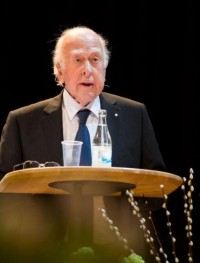Peter Higgs receives Royal Commission Medal

Professor Emeritus Peter Ware Higgs, Nobel Laureate in Physics 2013, has received the Royal Commission for the 1851 Exhibition Medal for his outstanding contribution to physics. The award was made at a Presidential Dinner on Tuesday 28th March 2017 by Princess Anne, the Princess Royal, at the Armourer’s Hall in the City of London.
It is only the third time the Medal has been awarded since its introduction in 2006. The first was awarded to His Royal Highness The Duke of Edinburgh on the fortieth anniversary of his Presidency. The second was presented to Sir Alan Rudge on his retirement as Chairman after eighteen years of service to the Commission. The Commissioners were unanimous in their decision to award the third to Professor Higgs.
Professor Peter Higgs
Peter Higgs held, as a postdoctoral researcher, a Royal Commission for the 1851 Exhibition Senior Studentship from 1953 to 1955. He spent the first year at King’s College London where he worked on what would now be described as theoretical chemistry. He spent his second year of 1954-1955 at the University of Edinburgh at the Department of Natural Philosophy. He remained in Edinburgh for the subsequent year of 1955-1956 as a Senior Research Fellow. He then returned to London, spending time at Imperial College and University College, until his appointment as a Lecturer in the Tait Institute of Mathematical Physics Mathematical Physics in 1960.
Professor Higgs went on to further his studies at Edinburgh and in the 1960s, he developed the theory of the Higgs Field and Higgs Mechanism. He was elected a Fellow of the Royal Society in 1983 and a Fellow of the Institute of Physics in 1991. He retired in 1996, becoming Professor Emeritus at the University of Edinburgh. In 2013, he received the Nobel Prize in Physics, jointly with François Englert, for “the theoretical discovery of a mechanism that contributes to our understanding of the origin of mass of subatomic particles”; a discovery that was confirmed by the ATLAS and CMS experiments at CERNs Large Hadron Collider.
The Royal Commission for the 1851 Exhibition
The Commission was originally founded by Prince Albert to organise the Great Exhibition of 1851 and then use its profits to “increase the means of industrial education and extend the influence of science and art upon productive industry”. With over 6 million visitors to the exhibition there was substantial profits which were used to purchase 87 acres of land in South Kensington stretching from Kensington Gore to Cromwell Road. Here they aided the establishment of the Victoria and Albert Museum, the Science Museum, the Natural History Museum, the Royal Albert Hall and Imperial College as well as the Royal College of Art and the Royal College of Music.
The Commission has a long history of supporting scientists and engineers for research, development and design through its awards programmes, which have been running since the 1890s. It has a total annual disbursement of £2.5m a year and, in addition to Professor Higgs, the Commission has funded twelve other scientists that have gone on to receive Nobel Prizes, including Sir James Chadwick, Ernest Rutherford and Paul Dirac.

